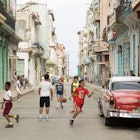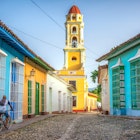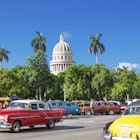
Feb 6, 2025 • 6 min read
If you’re planning to travel to Cuba with kids, you’ll find music, carnivals, watersports, horse riding, classic American car rides and much more.

Feb 6, 2025 • 6 min read
If you’re planning to travel to Cuba with kids, you’ll find music, carnivals, watersports, horse riding, classic American car rides and much more.

Feb 3, 2025 • 4 min read
Check this seasonal guide to Cuba's lively festivals, top beach weather and budget prices to find the best time for your visit.

Jan 28, 2025 • 8 min read
Get ready to uncover the buoyant and sophisticated magic of Cuba. Here are the top things to do on your visit.

Jan 18, 2024 • 4 min read
Travelers often have questions about the visa process for Cuba and whether US citizens can even visit. Here’s our guide to Cuba’s visa requirements.

Jan 10, 2024 • 7 min read
You can still see the best of Cuba even without a huge budget. Here are our tips on getting the most out of your money.

Jan 6, 2024 • 7 min read
From beaches to mountains to historic cities and more, these road trips around Cuba offer access to the best of this enchanting island.

Jan 8, 2023 • 7 min read
Want to travel around in Cuba? See the best of the island with our guide to transportation.

Nov 11, 2022 • 3 min read
Headed to Cuba soon? Don't go until you read Cuba expert Brendan Sainsbury's top tips on currency in the country.

Sep 13, 2022 • 11 min read
Here’s where to find the best traditional dishes around the country.

May 20, 2022 • 5 min read
The US has taken several steps toward thawing US-Cuba relations after five years of tightened restrictions. Here's what Americans need to know about traveling…

Feb 15, 2022 • 8 min read
Cuba is best known for its beaches, but it also has a little-explored network of national parks and protected areas that are worth hiking.

Feb 14, 2022 • 6 min read
From private homestays to all-inclusive hotels, Cuban accommodation needs some pre-trip thought. Here's how to stay, pay, (and allay any first-time fears).

Feb 3, 2022 • 5 min read
Classic cars are a popular tourist attraction in Cuba. Here's how to book yourself the perfect tour in an iconic vehicle.

Feb 2, 2022 • 5 min read
Circled by stretches of white sand and crystal clear waters, Cuba offers the perfect Caribbean escape. Here's a guide to Cuba's best beaches.

Dec 31, 2021 • 8 min read
Lonely Planet's Cuba travel expert visits the tropical island and reports back about his worthwhile trip.

Dec 20, 2021 • 7 min read
Visited by few foreign tourists, Cuba’s best national parks offer rugged tropical landscapes, diving through shipwrecks, astonishing wildlife and more.

Oct 27, 2020 • 8 min read
Travel writer Brendan Sainsbury is an expert on travel to Cuba. This is his first time returning since the global pandemic began.

Jun 16, 2020 • 5 min read
For decades, Cuba's female professionals have been redefining the country's art scene and exploring new avenues for income.

May 7, 2020 • 3 min read
Whether it's the fluid movements of salsa dancers, the blare of a trumpet or the waft of cigar smoke in the air, Cuba is a country that lingers in the mind.

Sep 3, 2019 • 7 min read
Despite a well-publicized announcement by the Trump administration in June 2019, it is still relatively easy for Americans to travel legally to Cuba.

Jun 12, 2019 • 4 min read
In the space of three years, US-Cuban relations have gone from cagey cooperation to the tetchy squabbling of yore. On June 4, the Trump administration…

Jun 5, 2019 • 3 min read
Travel to Cuba just got more difficult for Americans after the Trump administration announced a ban on cruise ships, private planes and boats to the…